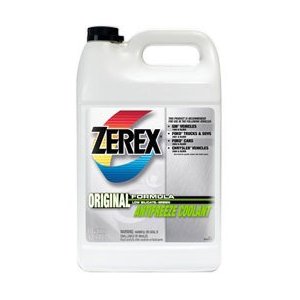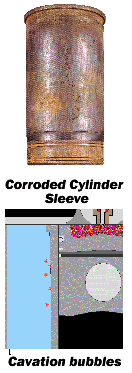Protect Your Engine with the Right Antifreeze
Updated July 6, 2012
Note for Hummer Owners:
 What I have personally done is gone back to regular antifreeze. The cast iron block of our GM 6.5 engine is not affected by cavitation to the same extent as other engines because of the cylinder wall thickness.
Our engine does not have a sleeved cylinder wall. This doesn't mean that your engine is not affected by cavitation only that it hasn't been a problem in this particular engine.
What I have personally done is gone back to regular antifreeze. The cast iron block of our GM 6.5 engine is not affected by cavitation to the same extent as other engines because of the cylinder wall thickness.
Our engine does not have a sleeved cylinder wall. This doesn't mean that your engine is not affected by cavitation only that it hasn't been a problem in this particular engine.



General Information for Diesel owners:
Antifreeze is one of the most important fluids in your car. Antifreeze is mixed with water to make the coolant for your engine. In addition to providing freeze and boil protection, properly formulated antifreeze protects your engine components and radiator from corrosion. After talking with another Hummer owner. I found out that diesel engines have another issue that almost nobody knows about. The best way to describe it is from this email that I got off a Ford newsgroup.
I am an owner of a 1989 Ford F350 PU that has a 7.3 Liter Diesel Engine...or should I say had. After 108,000.00 miles, my motor developed pin holes in the block which caused major damage. I serviced the truck, including changing the coolant, and maintained detailed and accurate records. However, this did not help because I never added a coolant conditioner which is very important in diesel engines. Ford does not even mention this conditioner in their maintenance guide! And to make matters worse, two local Ford dealerships which serviced my truck in the past said they never heard of this problem. I now have a truck that is useless. After calling Ford and informing them of the problem I was told that the truck is out of warranty, which doesn't help me one bit.
The problem is called Cylinder Liner Cavitation. To date I haven’t heard of any problems with the 6.5 diesels in Hummers. With the healthy market in used trucks it won’t be long until there is a large population of trucks that have over or near 100 thousand miles. The problem is best explained in the following article written by Ed Eaton at Amalgamated Laboratories, Inc.
One of the most common and costly results of improper cooling system maintenance is the perforation of wet-sleeve cylinder liners. The perforation is caused by repetitive pitting of the liner resulting from liner vibration. As the fuel inside ignites, the liner vibrates within the block. The outside wall of the liner actually moves away from the coolant causing a near vacuum for an instant. This low-pressure causes the surrounding coolant to boil, forming tiny bubbles. The liner then returns to its position with extremely high velocity, pressing against the bubbles with a violent force. The bubbles implode (collapse) against the liner wall surface at pressures up to 60,000 PSI. The collapse of these bubbles blasts small holes in the steel liner. This pitting process will repeat, digging tiny tunnels through the liner. This will eventually perforate the wall allowing coolant to enter the combustion side of the cylinder.
Correctly formulated coolant contains either nitrite or a combination of nitrite and molybdate. They will form a thin protective oxide film on the coolant side of the liner wall. This oxide film, which is formed by reaction of the nitrite with the liner wall, acts as a protective barrier to prevent corrosion and cavitation from occurring. In a properly protected system, the imploding bubbles attack the protective film. The film quickly heals over the liner by drawing nitrite from the coolant. In an improperly protected system, the bare metal surface area is immediately exposed to cavitation forming a corroded pit in the metal.
If coolant gets into the engine it will probably trash it. The engine will either hydrolock or burn up with water in the oil. The potential for liner pitting increases in cold weather. When an engine is cold, engine vibration increases because of increased piston-to-cylinder clearance and because the engine has a tendency to lug in cold weather. Engines where loads fluctuate rapidly, such as school and transit buses, and delivery trucks experience more vibration and are more prone to pit.
Fortunately the solution to this problem is as simple as using the right kind of antifreeze. Although there are two dominant technologies, the one that will work best for the Hummer is the Penray (Nalcool) technology. It’s more friendly to the Hummer’s radiator and water pump and is more forgiving if you use too much. This family of products is provided to the aftermarket as Old World Industries Fleet Charge, Prestone Heavy duty AF977, Pencool 3000, Detroit Diesel PowerCool, GM Good Wrench SCA, Caterpillar diesel coolant additive, and most recently Shell has come out with a premixed 50/50 Rotella ELC (extended life coolant) which is supposed to last for 300,000 miles. This is what I'm now using.
The Rotella ELC is a Dexcool based antifreeze. See the info below on Dexcool issues. As of June 2004 I personally have had it in my 98 Hummer for 2 years. I checked it out and the whole cooling system is clean as a whistle and the PH of the coolant is 8. A PH of 8 is slightly alkaline which is what you want it to be.
Because I'm conservative I'll keep my eye on it and recommend that you change it out and flush your system as if it wasn't an extended life coolant. This would be around 2 years or 30,000 miles.
I had a real hard time finding these kinds of antifreeze. Nobody knew what I was talking about.One of the local Hummer dealers found it for me. They sent the spec sheet for Fleet Guard to AM General and got it approved.
The best preventative maintenance for your cooling system is to provide it with a 50/50 mixture of coolant and de-mineralized water (distilled, RO or DI) followed up by a check of the cooling system at six month intervals. At this time if the cooling system requires the addition of coolant, always pre-mix the 50/50 mixture in a separate container and add the mixture to the cooling system. Never add just water to top off or just coolant to top off. This will either dilute the chemistry that protects your engine or create an excess concentration of antifreeze. My recommendation is to flush and change your antifreeze every other year unless you are using the permanent Rotella. This will ensure that the chemical protection will not be depleted.
Make sure that you use a 50/50 mixture of antifreeze and water. Pure antifreeze will not conduct heat and cause the engine to over heat.
Water is a very key ingredient to this mixture. More precisely, the quality of the water is nearly as important as all other components. Usually, municipal water supplies are laden with minerals and as for well water, this water is the worst offender of all. Never use well water in your cooling system. Water heavy with mineral salts will cause engine scaling and reduce the ability of the engine to transfer heat and will ultimately contribute to premature failure. Scale can form on water pump seal surfaces causing the pump to fail. It is critical that all cooling system heat exchange surfaces remain clean. Hard water scale can block a cooling system’s ability to transfer heat resulting in overheating. Only 1/16 in of scale will reduce cooling system heat transfer efficiency by 40%.
Finally, remember most antifreeze contains ethylene glycol, a poisonous chemical. Always keep both new and waste antifreeze in tight containers and store them carefully so that pets and more importantly children will not get into them.
A word about DexCool Antifreeze
There is a class action suit pending against GM claiming that cooling systems were corroded and sludged up due to the extended life antifreeze Dexcool. Below is text from the lawsuit:
Dexcool was initially marketed as a long life universal automotive engine coolant that would last for 5 years or 100,000 miles of service. It is now marketed to last for 5 years or 150,000 miles of service. Manufacturers of traditional antifreeze / coolants generally market that their antifreeze / coolants will provide dependable thermal control and corrosion and rust protection for twenty-four (24) months or 30,000 miles. The major difference in Dexcool over traditional coolants is in the corrosion inhibitor protection. Traditional antifreeze / coolants contain inorganic salts of borate, phosphate, silicate and other chemicals to prevent rust and corrosion, whereas, Dexcool’s® corrosion inhibitor components, are based on organic acid technology (OAT). Dexcool is orange and traditional antifreeze is green.
I've done some research on the subject and found that the biggest problem seems to be contamination of Dexcool with regular antifreeze and running your cooling system low on coolant. Many systems get contaminated when owners get their oil changed at a quick lube which tops off all the fluids.

